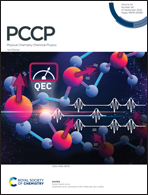First-principles study of two-dimensional C-silicyne nanosheet as a promising anode material for rechargeable Li-ion batteries†
Abstract
Li-ion batteries are one of the sustainable alternatives to meet the growing energy demands of an increasing population. However, finding a suitable negative electrode is key for improving battery performance. In the present work, first principles-based investigations are carried out to explore the capability of a planar 2D C-silicyne nanosheet – which is a Si analogue of α-graphyne having –C![[triple bond, length as m-dash]](https://www.rsc.org/images/entities/char_e002.gif) C– substitution – as an anode for improving the performance of Li-ion batteries. Thermally and dynamically stable C-silicyne sheets exhibit a metallic nature as inferred from the density of states studies. The average adsorption energies for sequential adsorption of the Li atom over the monolayer range from −1.35 to −0.46 eV, implying favourable interactions between the monolayer and the Li atom which indicate that during the lithiation process, clustering amongst the metal atoms is not preferred. The energy barrier for the migration of Li-ions is 0.21 eV, indicating an active charge/discharge process. A high storage capacity of 836.07 mA h g−1 and a working potential of 0.60 V is obtained. A negligible amount of volume change of the C-silicyne monolayer after full lithiation is observed which implies good cyclability. All these outcomes imply that C-silicyne nanosheets are a potential anode material for next-generation LIBs.
C– substitution – as an anode for improving the performance of Li-ion batteries. Thermally and dynamically stable C-silicyne sheets exhibit a metallic nature as inferred from the density of states studies. The average adsorption energies for sequential adsorption of the Li atom over the monolayer range from −1.35 to −0.46 eV, implying favourable interactions between the monolayer and the Li atom which indicate that during the lithiation process, clustering amongst the metal atoms is not preferred. The energy barrier for the migration of Li-ions is 0.21 eV, indicating an active charge/discharge process. A high storage capacity of 836.07 mA h g−1 and a working potential of 0.60 V is obtained. A negligible amount of volume change of the C-silicyne monolayer after full lithiation is observed which implies good cyclability. All these outcomes imply that C-silicyne nanosheets are a potential anode material for next-generation LIBs.



 Please wait while we load your content...
Please wait while we load your content...